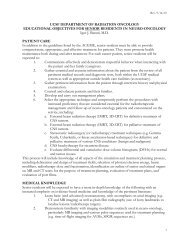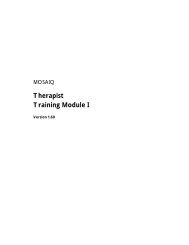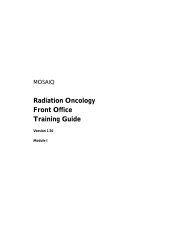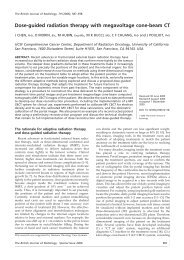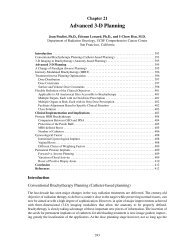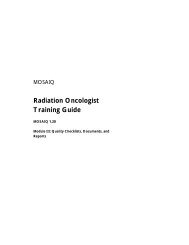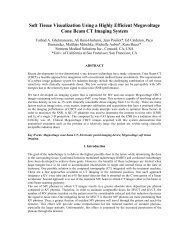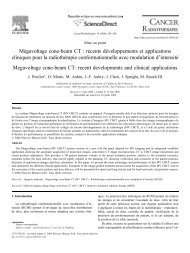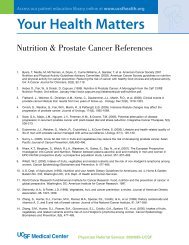(Prostate, GI and H&N) - UCSF Radiation Oncology
(Prostate, GI and H&N) - UCSF Radiation Oncology
(Prostate, GI and H&N) - UCSF Radiation Oncology
You also want an ePaper? Increase the reach of your titles
YUMPU automatically turns print PDFs into web optimized ePapers that Google loves.
Overview of<br />
Treatment techniques<br />
at <strong>UCSF</strong><br />
(<strong>Prostate</strong>, <strong>GI</strong> <strong>and</strong> H&N)<br />
O.Morin<br />
Physics Resident Talk<br />
04/29/09
• “Good to know” facts<br />
• Anatomy (targets)<br />
• Treatment options<br />
Outline<br />
• Gold st<strong>and</strong>ard for treatment<br />
• New treatment techniques<br />
<strong>Prostate</strong><br />
<strong>GI</strong><br />
Head <strong>and</strong> neck
Methods <strong>and</strong> equipment<br />
to administer Tx<br />
• Linacs<br />
• IORT<br />
• Cyberknife<br />
• Brachytherapy<br />
EBRT<br />
Important question:<br />
Monotherapy,<br />
boost, palliative or<br />
salvage
<strong>Prostate</strong>-Pearls<br />
• Number one non-cutaneous cancer in men.<br />
• Nearly 50-80% of tumors involve the prostate apex<br />
<strong>and</strong> roughly 85% of patients have multifocal disease in<br />
the prostate.<br />
• Most frequently used prognosis factors are Gleason<br />
score, clinical stage <strong>and</strong> pretreatment PSA.<br />
• MR spectroscopy shows decrease citrate <strong>and</strong> increase<br />
choline but its role in routine management has not yet<br />
been studied.
<strong>Prostate</strong>-Pearls<br />
• Lymph node drainage is primarily to the internal iliac<br />
obturator, external iliac, common iliac, <strong>and</strong> paraaortic<br />
nodes.<br />
• Risk-classification schemed <strong>and</strong> nomograms are used<br />
to help guide treatment decisions.
<strong>Prostate</strong> Anatomy<br />
Base<br />
Apex
<strong>Prostate</strong> Cancer Staging
• Surgery<br />
<strong>Prostate</strong> Tx options<br />
• <strong>Radiation</strong> therapy<br />
• Hormone therapy<br />
• Cryosurgery<br />
• Chemotherapy<br />
• Biologic therapy<br />
• Thermal therapy<br />
EBRT alone<br />
EBRT + cyberknife boost<br />
EBRT + PPI boost<br />
PPI alone<br />
EBRT + HDR<br />
HDR alone
<strong>Prostate</strong> Tx <strong>UCSF</strong><br />
• At <strong>UCSF</strong>, patients are treated supine with alpha<br />
cradle immobilization with ankle block.<br />
• Patients are instructed to have full bladder <strong>and</strong><br />
empty rectum for simulation.<br />
• Daily imaging (portal images or MVCBCT) is used<br />
to monitor prostate motion.<br />
• Gold markers implanted in the prostate 7-10 days<br />
prior to simulation serve as surrogate for the<br />
prostate.
Traditional whole pelvis RT + cone down boost<br />
1. 4 fields<br />
2. 4 to 7<br />
3. <strong>Prostate</strong> only<br />
1.8 Gy/fx
Traditional whole pelvis RT + cone down boost<br />
1. 4 fields<br />
2. 4 to 7<br />
3. <strong>Prostate</strong> only<br />
1.8 Gy/fx
Traditional whole pelvis RT + cone down boost<br />
1. 4 fields<br />
2. 4 to 7<br />
3. <strong>Prostate</strong> only<br />
1.8 Gy/fx
IMRT<br />
<strong>Prostate</strong> with node coverage
IMRT<br />
<strong>Prostate</strong> with node coverage
IMRT<br />
<strong>Prostate</strong> with node coverage<br />
Spinal cord
Current practice at <strong>UCSF</strong><br />
<strong>Prostate</strong>:<br />
3D CRT:<br />
High-Risk:<br />
- 45 Gy Whole Pelvis<br />
- 54 Gy Prost. + Seminal Vesicles<br />
- 74 Gy Prost.<br />
Low-Risk:<br />
- 54 Gy Prost. + Seminal Vesicles<br />
- 74 Gy Prost.<br />
Approximately 40 fractions<br />
IMRT:<br />
- 54 Gy Seminal Vesicles<br />
- 77 Gy <strong>Prostate</strong><br />
Approximately 33 fractions<br />
12
Current practice at <strong>UCSF</strong><br />
<strong>Prostate</strong>:<br />
Daily alignment based on<br />
gold seeds using EPID<br />
12
Current practice at <strong>UCSF</strong><br />
<strong>Prostate</strong>:<br />
Daily alignment based on<br />
gold seeds using EPID<br />
12
Current practice at <strong>UCSF</strong><br />
<strong>Prostate</strong>:<br />
Daily alignment based on<br />
gold seeds using EPID<br />
R<br />
I<br />
A<br />
P<br />
S<br />
L<br />
12
HDR<br />
<strong>Prostate</strong> Tx Brachy<br />
As a boost: 45 Gy EBRT + HDR 2 fx x 9.5 Gy<br />
Monotherapy: 3 fx x 10.5 Gy, 9.5 Gy BID x 2 days<br />
Salvage (re‐treatment): 2 implants x 3 fx of 6.0 Gy<br />
PPI<br />
Monotherapy: I-125 (144 Gy), Pd-103 (125 Gy).<br />
After 40-50 Gy EBRT: I-125 (110 Gy), Pd-103 (90 Gy).
Gastrointestinal (<strong>GI</strong>)<br />
• 22,000 new cases, 12,000<br />
deaths from gastric cancer each<br />
year in the US.<br />
• Pancreatic cancer is 5th leading<br />
cause of cancer mortality<br />
although only 9th most<br />
common.<br />
• 5% of <strong>GI</strong> are esophagus.<br />
• Colorectal cancer is the third<br />
most frequently diagnosed<br />
cancer in US.
<strong>GI</strong>-Lymph nodes
<strong>GI</strong>-Tx options<br />
• Patient simulated in supine <strong>and</strong> prone (anal) position.<br />
• EBRT: 3DCRT or IMRT<br />
• Cyberknife showing good encouraging results (liver).<br />
• May need to use more 18X photon beams with<br />
EBRT.<br />
• Large margins required for liver, stomach <strong>and</strong><br />
pancreas.<br />
• PET may be useful but not routinely used.<br />
• Nearly all plans are CT based.
Esophagus
Esophagus<br />
Esophagus
Esophagus<br />
Esophagus<br />
Spinal cord
Stomach
Stomach<br />
Stomach
Stomach<br />
Stomach<br />
Spinal cord
Anal CancerAnal Cancer
Anal CancerAnal Cancer<br />
Spinal cord
Weekly portal imaging<br />
Patient setup
Head <strong>and</strong> Neck (HN)<br />
• Nasopharynx<br />
• Nasal cavity <strong>and</strong> paranasal<br />
sinus<br />
• Oropharyngeal<br />
• Lip <strong>and</strong> oral cavity<br />
• Larynx <strong>and</strong> hypopharynx<br />
• Salivary gl<strong>and</strong>s<br />
• Thyroid cancer
Head <strong>and</strong> Neck (HN)<br />
• Nasopharynx<br />
• Nasal cavity <strong>and</strong> paranasal<br />
sinus<br />
• Oropharyngeal<br />
• Lip <strong>and</strong> oral cavity<br />
• Larynx <strong>and</strong> hypopharynx<br />
• Salivary gl<strong>and</strong>s<br />
• Thyroid cancer
HN-Tx Options<br />
• EBRT: 3DCRT or IMRT<br />
• Rarely use electron with <strong>and</strong> without bolus<br />
• Brachy (floor of mouth, base of tongue, etc.)<br />
• Cyberknife (salavage nasopharynx, orbit, optic<br />
nerve, etc.)
HN-Target volumes<br />
Several tumor volumes are often dePined for head <strong>and</strong> neck treatment. <br />
Generally they are dePined as follows:<br />
GTV = clinical <strong>and</strong>/or radiographic gross disease<br />
CTV1 = site speciPic margin on primary &/or nodal GTV, microscopic <br />
spread.<br />
CTV2 = elective neck, low‐risk nodes determined by the clinician.<br />
Other treatment volumes may be present depending on the doctor.
• CT based plan<br />
HN-Tx details<br />
• CT with contrast, PET <strong>and</strong> MR greatly used.<br />
• Thermoplastic mask covering the shoulders<br />
• Neck holder (TIMO)<br />
• Dental mold<br />
• 3D CRT, IMRT <strong>and</strong> electron<br />
• Bolus for superficial tumor<br />
• Should not need 18X photon beam<br />
• Not always uniformly distributed beam angles
Base of tongue
Base of Base tongue of tongue
Dose tolerance:<br />
EBRT using 1.82.0 Gy per fraction<br />
Stereotactic radio surgery<br />
Whole brain
Current practice at <strong>UCSF</strong><br />
Head <strong>and</strong> Neck:<br />
Plan <strong>and</strong> prescription:<br />
IMRT:<br />
- 70 Gy GTV (visible tumor, (+) lymph nodes)<br />
- 59.4 Gy CTV1 (Risk of microscopic disease + )<br />
- 54 Gy CTV2 (Risk of microscopic disease)<br />
PTV: 2-5 mm margin<br />
Approximately 33 fractions<br />
28
Current practice at <strong>UCSF</strong><br />
Head <strong>and</strong> Neck:<br />
Plan <strong>and</strong> prescription:<br />
IMRT:<br />
- 70 Gy GTV (visible tumor, (+) lymph nodes)<br />
- 59.4 Gy CTV1 (Risk of microscopic disease + )<br />
- 54 Gy CTV2 (Risk of microscopic disease)<br />
PTV: 2-5 mm margin<br />
Approximately 33 fractions<br />
Setup:<br />
Thermoplastic mask<br />
EPID or MVCBCT ONCE A WEEK<br />
AP<br />
LAT<br />
28
MVCBCT:<br />
Patient setup
Overview of<br />
Treatment techniques<br />
at <strong>UCSF</strong><br />
(<strong>Prostate</strong>, <strong>GI</strong> <strong>and</strong> H&N)<br />
O.Morin<br />
Physics Resident Talk<br />
04/29/09




